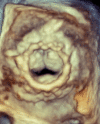Challenging Case of Transcatheter Mitral Valve-in-Valve-in-Valve Replacement
- PMID: 36632025
- PMCID: PMC9843647
- DOI: 10.12659/AJCR.938415
Challenging Case of Transcatheter Mitral Valve-in-Valve-in-Valve Replacement
Abstract
BACKGROUND A 39-year-old man with a complex valvular history of recurrent methicillin-resistant Staphylococcus aureus endocarditis with 2 surgical mitral valve replacements (in 2016 and 2017) followed by transcatheter mitral valve replacement (in 2019) presented with orthopnea, paroxysmal nocturnal dyspnea, chest pain, cough, and progressively worsening dyspnea on exertion. CASE REPORT Extensive workup was performed, including transesophageal echocardiogram, which revealed a malfunctioning, severely stenotic bioprosthetic valve. Left and right heart catheterization revealed mild non-obstructive coronary artery disease and severe pulmonary hypertension. Given the patient's complex medical history, he was deemed to be at an elevated risk for repeat sternotomy and repeat valve replacement surgery. Therefore, he underwent a percutaneous transcatheter mitral valve replacement with a 26-mm SAPIEN 3 Edwards valve placed within the previous 29-mm SAPIEN valve. Post-procedural imaging revealed a well-placed valve with an improved mitral valve gradient. CONCLUSIONS This is one of the few rare cases of mitral valve-in-valve via a transcatheter mitral valve replacement approach with successful deployment of a SAPIEN 3 tissue heart valve. The patient experienced significant reversal of heart failure symptoms and improved exertional tolerance following deployment of the valve and was eventually discharged home in a stable condition.
Conflict of interest statement
Figures









References
-
- Nkomo VT, Gardin JM, Skelton TN, et al. Burden of valvular heart diseases: A population-based study. Lancet. 2006;368(9540):1005–11. - PubMed
-
- Chambers HF, Bayer AS. Native-valve infective endocarditis. N Engl J Med. 2020;383(6):567–76. - PubMed
-
- Urena M, Vahanian A, Brochet E, Ducrocq G, Iung B, Himbert D. Current indications for transcatheter mitral valve replacement using transcatheter aortic valves. Circulation. 2021;143(2):178–96. - PubMed
-
- Mack M, Carroll JD, Thourani V, et al. Transcatheter mitral valve therapy in the United States. J Am Coll Cardiol. 2021;78(23):2326–53. - PubMed
-
- Stone GW, Lindenfeld JA, Abraham WT, et al. Transcatheter mitral-valve repair in patients with heart failure. N Engl J Med. 2018;379(24):2307–18. - PubMed
Publication types
MeSH terms
LinkOut - more resources
Full Text Sources
Medical

